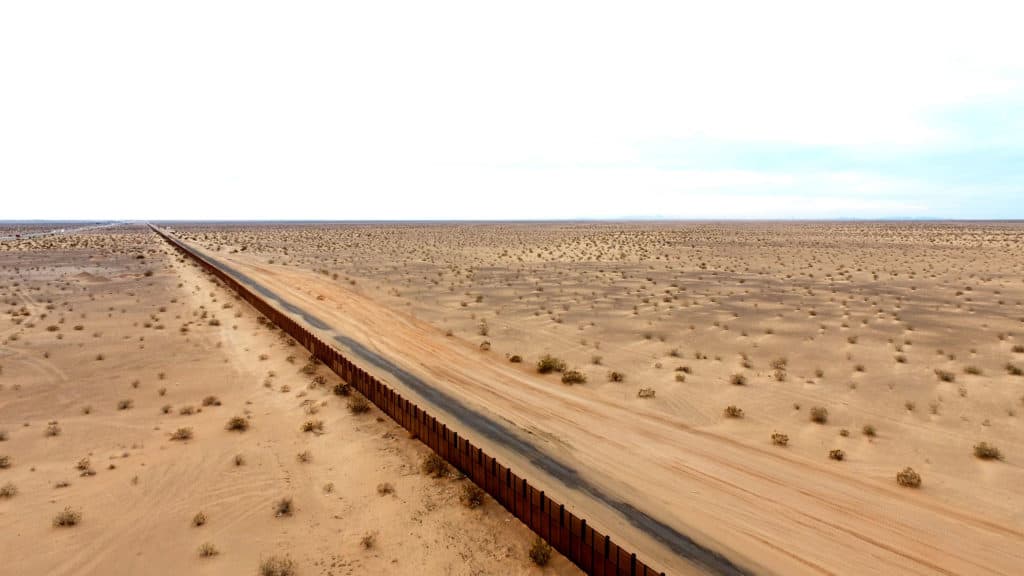While Other Controversies Rage, Work on Border Wall Moves Forward
Byron York, Washington Examiner, May 29, 2017

Photo taken on Feb. 10, 2017 shows the wall that divides Mexico and the United States in the Mexican state of Sonora. (Credit Image: © [E]David De La Paz/Xinhua via ZUMA Wire)
Officials are quietly moving ahead on one of the president’s top campaign promises: the construction of a wall on the U.S.-Mexico border. Although it hasn’t received much attention relative to the president’s many problems, extensive planning for the wall is under way, officials are evaluating specific proposals, sites are being studied, and yes, there is money available to get going.
The work is being done under President Trump’s executive order of Jan. 25, which declared the administration’s policy to “secure the southern border of the United States through the immediate construction of a physical wall …” The order went on to set a high standard of effectiveness: “the prevention of all unlawful entries into the United States” along the border. Finally, the order cited an existing law, the Secure Fence Act, which in 2006 called for the construction of “at least two layers of reinforced fencing” and “additional physical barriers” on up to 700 miles of the 1,954-mile border.
“The executive order calls on the authority in the Secure Fence Act for us to begin immediately,” said a senior administration official who recently provided an extensive update on the state of the wall project. In March, U.S. Customs and Border Protection sent out a request for proposals for companies to bid on the construction of prototypes — not little models to sit on someone’s desk, but full-scale sections of proposed wall designs that will be put in place on the border. So far, Border Protection has received more than 100 proposals.
“We are evaluating what started out as a solicitation to industry and request for proposals — 18 to 30 feet high, concrete, impenetrable, hard-to-scale, the correct aesthetics,” the official said.
{snip}
There are some important points to remember before going any further. First, there is no intention to build a wall to stretch the entire border, from San Diego, Calif., to Brownsville, Texas. In his campaign, the president made clear that the wall need not cover every mile of the border.
{snip}
And the wall does not always mean a wall. The Jan. 25 executive order defined “wall” as “a contiguous, physical wall or other similarly secure, contiguous and impassable physical barrier.” Planners say that in practice, that will certainly mean extensive areas with an actual wall. But other areas might have the type of fencing outlined in the Secure Fence Act, or some other barrier yet to be designed.
And that leads to a third point: The border barrier will not look the same at all points along the border. The terrain of the border is different — some parts are so imposing they don’t need a barrier at all — and officials plan to design walls and barriers that fit each area, rather than one long, unchanging structure.
Right now, officials are studying how many “buildable miles” will need a barrier. Whatever the precise number, it will be big. In 2015, the Department of Homeland Security told Congress that, of the 1,954 miles of border, 1,300 miles, or 66.5 percent, have no fencing or barriers at all; 299.8 miles, or 15.3 percent, have vehicle fence; and 316.6 miles, or 16.2 percent, have pedestrian fence. Only 36.3 miles, or 2 percent, have the kind of double-layer fencing required by the Secure Fence Act. (The law was passed by Congress and signed by President George W. Bush, but neither Bush nor Congress really wanted to build the fence. So they didn’t.)
{snip}
At the moment, planners believe that about 700 “buildable miles” of the border will require a wall or other barrier. That just happens to be about the same amount called for in the Secure Fence Act.
{snip}
Whatever barrier is built, Border Protection agents on the U.S. side need to be able to see through it.
{snip}
A wall isn’t just a wall. It is a system — a “smart wall,” as they call it. It involves building a barrier with the monitoring technology to allow U.S. officials to be aware of people approaching; to be able to track them at all times; to have roads to move people around; the facilities to deal with the people who are apprehended; and more. “It’s not just a barrier,” noted the official. (Last year, with the Obama administration still in office, a number of Border Protection officials traveled to Israel to study that country’s highly effective barriers; they came home big believers in a smart wall.)
{snip}
After the recent spending bill passed, some opponents of the wall declared the project dead. (Sample headline: Vanity Fair’s “How Trump’s Wall Failure Will Forever Doom His Presidency.”) But any victory dance right now is premature. Yes, it’s certainly possible the wall won’t be built. But it’s also possible it will be built, or that significant parts of it will be built. The work is already under way.















